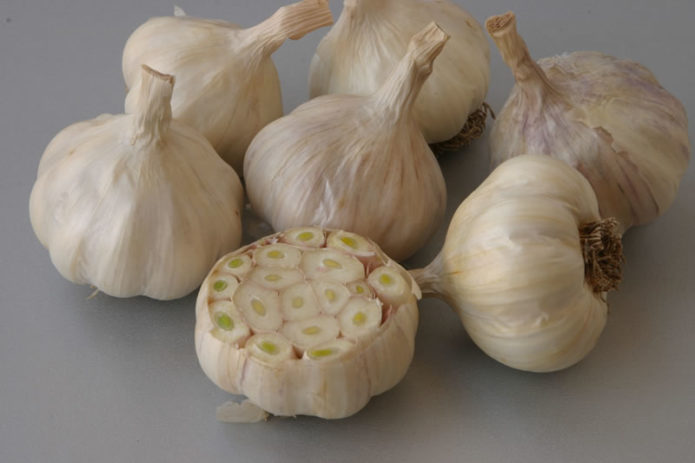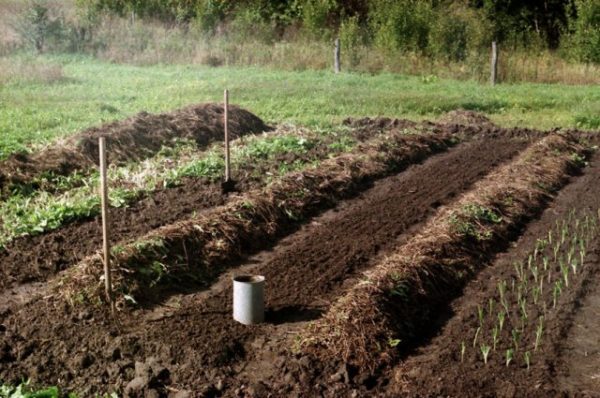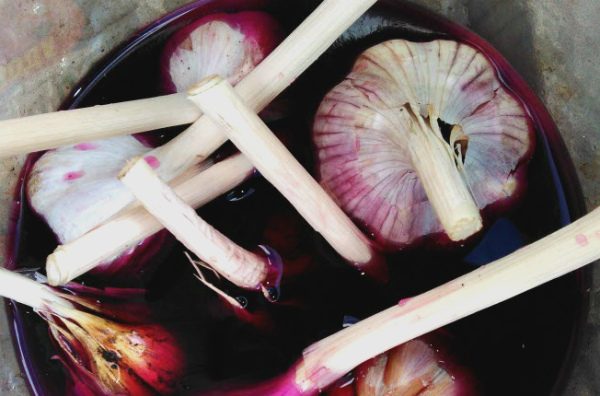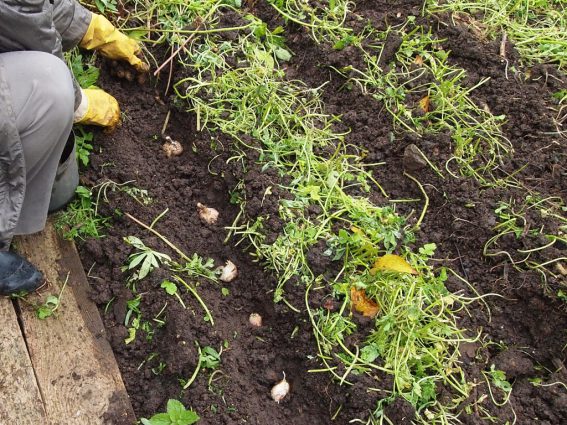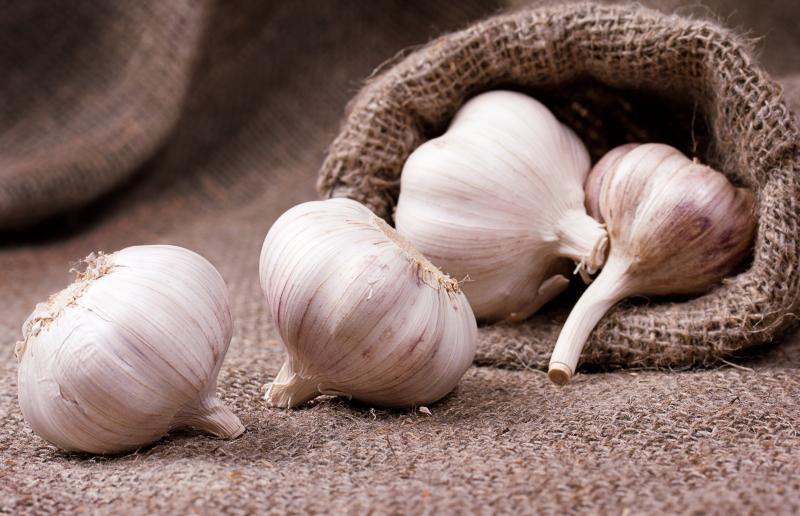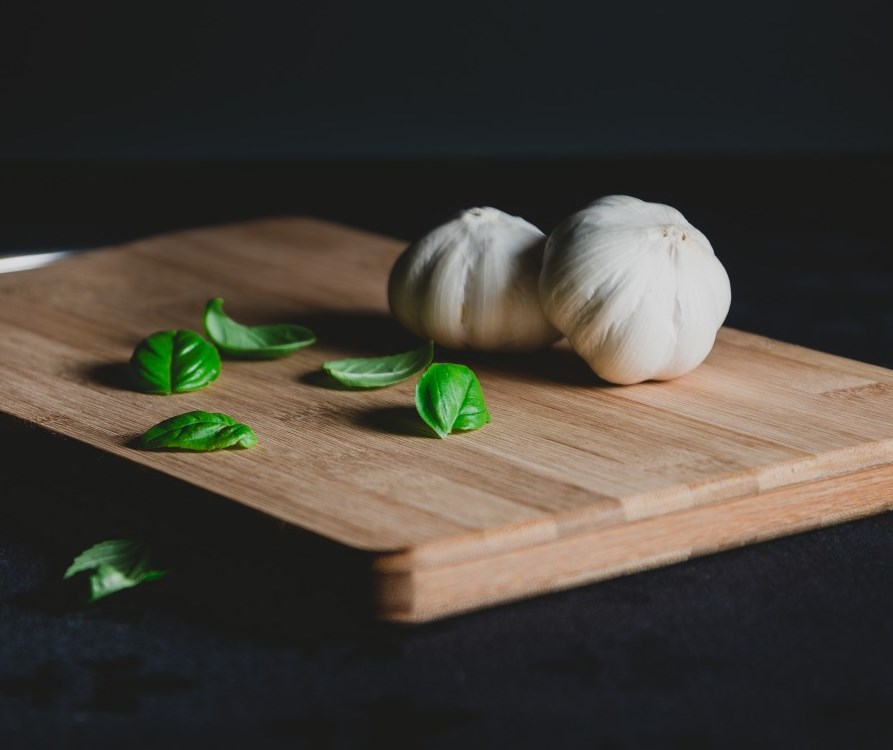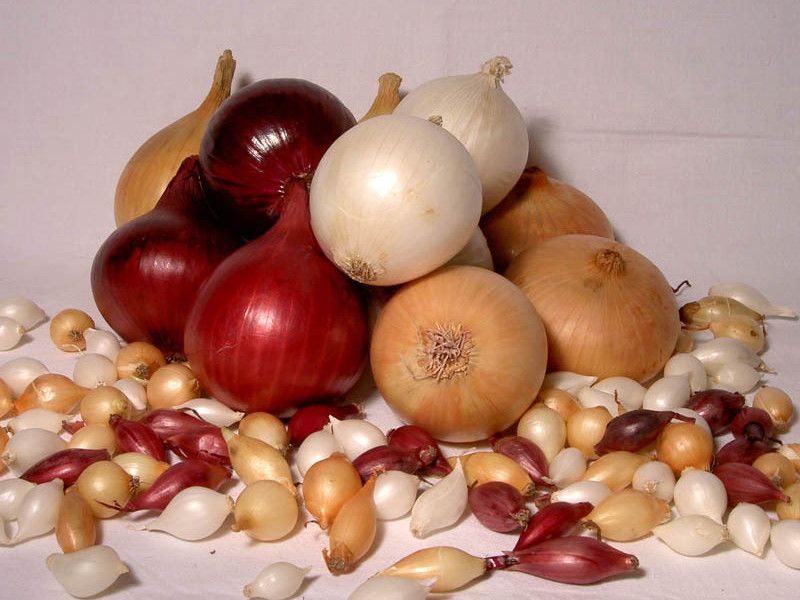Experienced gardeners know that garlic can be winter and spring. The first is planted before winter, that is, in late autumn, and the second in spring. However, the difference lies not only in the timing of planting, but also in appearance and other features. To get strong, juicy fruits with a spicy aroma and "vigorous" aftertaste, you need to plant garlic in the fall before winter. There are subtleties and secrets that every summer resident should know.
Content
Spring and winter garlic: features and differences
Even an inexperienced summer resident will be able to distinguish winter varieties of vegetables from spring (spring) ones due to obvious external differences.
Table: differences between winter crops and spring crops
| Winter | Spring |
|
|
Winter garlic is resistant to diseases and negative environmental conditions, is not afraid of frost and gives a large harvest.
A vegetable planted in autumn is harvested earlier than spring. Thanks to this, gardeners have the opportunity to plant another crop in its place.
There are many varieties of winter garlic, which differ from each other in terms of vegetation, appearance and other characteristics.
- Alcor. A medium-ripening variety that produces a high yield of rounded pink-purple bulbs. It is resistant to low temperatures, but is susceptible to some diseases.
- Gribovsky jubilee. Mid-season variety of culture. It tolerates drought and frost well, is rarely affected by bacteria and fungi. Fruiting in round, slightly flattened bulbs with purple skin.
- Lyubasha. High-yielding variety with rounded flat fruits covered with white or pale pink scales. Garlic belongs to the mid-season varieties, resistant to negative factors and fungal diseases.
- Belorussian. An early ripening variety produces large bulbs with firm flesh and off-white skin. Resistant to frost, practically not susceptible to infection with bacterial rot.
- Moscow Region. A high-yielding variety of garlic. The bulbs are round, the skin is white with brownish-purple veins. It is not afraid of frost, it is immune to diseases.
- Sail. Large, slightly flattened bulbs, covered with white husk with a slight purple tint. It gives a large harvest, is not afraid of frost, practically not affected by fungal diseases, but not too resistant to peronosporosis.
- Sofievsky. Mid-season variety with mssy bulbs and light purple scales. Resistant to frost, but can be affected by a nematode.
- Spas. A mid-season variety that gives a large yield and is resistant to the most common diseases. The bulbs are round, covered with a grayish husk with indistinct purple streaks.
The only drawback of winter garlic is that not all varieties are well stored in winter, so it is better to consume them as soon as possible or use them for preservation.
Planting dates for winter garlic
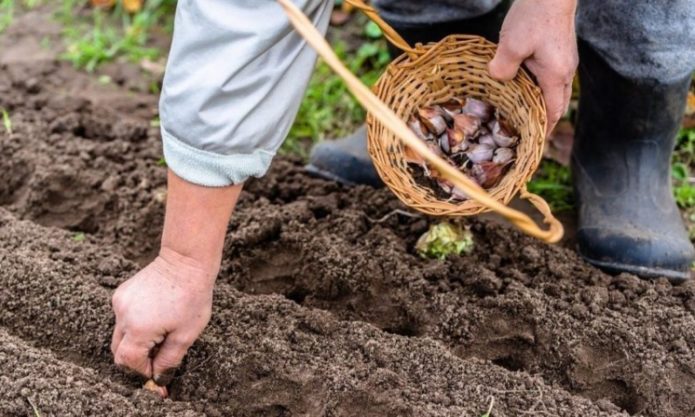
Rooted, albeit slightly sprouted, plants tolerate winter better than garlic with an unformed root system
The key to the success of growing winter garlic lies in the correct timing of sowing activities. The culture must be planted so that before the first frost it has time to form strong roots. If done later, frost damage can damage or destroy plantings. But garlic planted too early can also not give the desired amount of harvest - if the seed germinates, the first frosts will destroy the tender sprouts.
The optimum temperature to start planting garlic is 12-150C, that is, around the end of September or the beginning of October, depending on the region. In the middle lane, the procedure is usually carried out between September 20 and October 15. Another way to correctly calculate the timing is to subtract a month and a half from the start date of the first frosts. If the weather is unstable, which makes it difficult to make an accurate calculation, it is better to plant the garlic a little earlier.
Site and soil selection
It is not recommended to plant garlic in one place for several years in a row - every year you need to choose new places, and you can plant it in the old plot in 3-4 years, so that the land has time to rest. The vegetable grows well after legumes and pumpkin crops, crucifers, leafy greens, bell peppers, grains and berries. But planting it after nightshades, onions and tomatoes is not recommended. Do not place garlic beds next to onion plantings, as they are prone to the same diseases.
Winter garlic feels best on sandy loamy soils with neutral acidity and close-lying groundwater, since the plantings need good moisture.
You should not choose plots for winter varieties that were fertilized with manure, as it acidifies the soil and oversaturated it with nitrogen. As a result, the culture will produce a large amount of greenery that will overtake the root system. The heads will become loose and susceptible to fungal infection. It is better to choose a place for planting with good lighting.
How to prepare a crop for planting in the fall
Unlike spring garlic, winter garlic can multiply both by chives and by air bulbs (bulbs), which are formed at the ends of the arrows. Experienced gardeners recommend choosing the first breeding option, since it will take at least two years to get a full-fledged fruit from an air bulb.
It is necessary to separate the cloves from the bulb only before planting, otherwise they will dry out and lose their ability to germinate. The teeth should be the same size, without rot, dents, cracks or other damage. Before planting, they should be sorted out, defective and infected specimens (with spots or black dots), as well as those with a broken shell, should be discarded. To improve germination and destruction of pathogenic microorganisms, planting material should be prepared - treated with antiseptic solutions:
- Dissolve 400 g of ash in two liters of water, boil for half an hour, then cool, hold the teeth for two hours.
- Dissolve 3 tbsp. l. salt in 5 liters of water, for 2 minutes. put the seed there, and then for 1 min. place the garlic in a solution of copper sulfate (a teaspoon per 10 liters of water).
- Prepare a light pink solution (0.05–0.1%) of potassium permanganate, keep the cloves selected for planting in it for a day.
Air bulbs are prepared for planting in a similar way, and after preparation, the seed is planted in the ground as soon as possible.
Soil preparation

The preparation of the garden consists in the introduction of fertilizers into the soil, which are necessary for the garlic.
Preparing the land for planting activities should begin two weeks in advance. The site is dug to a depth of 25 cm, humus is added in an amount of 5-6 kg per 1 m2 with the addition of 20 g of potassium salt and 30 g of superphosphate. After that, they dig it up again. Further, on the prepared site, you need to form beds at a distance of 12-15 cm from each other and leave them alone for several days for the soil to settle.
For antiseptic treatment of the soil after subsidence, it should be watered with a solution of copper sulfate - take 1 tbsp for 10 liters of water. l. substances, pour out a bucket of ready-made solution for every 2 m2... On the eve of landing on the surface of the earth, it is recommended to scatter urea - 10–20 g per 1 m2 and spill with water again.
Planting crops in the beds
There are many interesting methods for planting garlic. Let's consider the 2 most common.
Method number 1
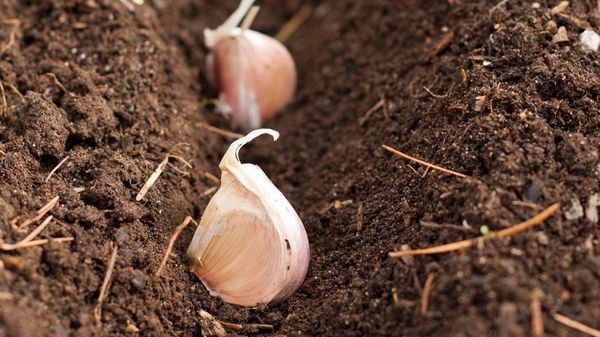
To protect against frost, it is not necessary to use a covering material - dry grass will do this task well.
Planting garlic on the beds is carried out according to the 10x15 cm scheme, and the sequence of actions is as follows.
- Make small holes or grooves 5–15 cm deep in prepared beds, depending on the size of the seed and planting time. The later the procedure is carried out, the deeper the seed should be planted, but it is better not to press the small teeth too hard. It is not recommended to deepen them by more than 15 cm, otherwise it will be difficult for garlic to germinate in spring, which will affect the quality of the bulbs.
- A small layer of clean coarse sand can be poured at the bottom of the grooves - it will exclude the contact of the teeth with the soil and protect them from decay. If there is no sand, you can skip this step.
- Plant the cloves with the sharp end up, but do not just stick them into the ground, but carefully lay them out and bury them in the ground. It is not recommended to water the plantings - if the ground is dry, watering can be done before planting.
- Mulch the area with dry peat (layer at least 2 cm), leaves, spruce branches or sawdust mixed with soil. In cold regions, the mulch layer should be at least 7-10 cm.
After planting the seed, it must be left alone. But you should not completely forget about it. After precipitation falls, it is necessary to ensure that the bed is well covered with snow - a natural shelter will help the culture to winter well. If the winter is snowless, you should cover the plantings with special material.
Air bulbs are planted in a similar way, but according to a different scheme. The distance between the grooves should be 10 cm, the interval between the bulbs should be 2 cm, the depth should not be more than 3 cm.
Method number 2
There is another, unconventional, but no less effective way of planting winter garlic, which requires peas, white mustard and oats.
- Land preparation begins at the end of August. The earth is fertilized with a mixture of potassium sulfate (2 tbsp. L. Per 1 m2), superphosphate (1 tbsp. l.), wood ash (2 tbsp.), chalk (1 tbsp.), humus (10 kg). All dressings are mixed and scattered dry over the soil surface.
- The soil is dug up and spilled with water for better subsidence - in rainy weather it is not necessary to water the site.
- Form a bed, and plant peas, white mustard and oats at a distance of 35–45 cm from it.
- When the seeds hatch and the sprouts reach 20 cm, you can plant garlic in rows. 1-2 days before the procedure, add urea (10-20 g per 1 m2) and water the soil well.
This method of planting is effective, since green sprouts trap snow and reliably cover the garlic from frost. In winter, they will moisten the site, after which they can be embedded in the soil and receive nutritious organic fertilizer.
Secrets and subtleties
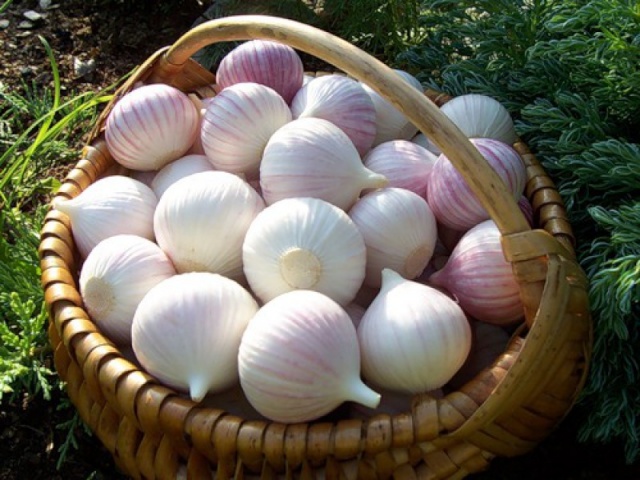
Before planting, it is advisable to free the garlic from the "mother" bottom so that the plant develops faster
- For cultivation, it is better to choose varieties of garlic that take root well in a particular area.
- The solutions used to soak the seed should be at room temperature, and after processing, the cloves should be dried.
- When choosing the timing of planting a crop, you should focus not on calendars or other factors, but on the weather. If the autumn is warm and mild, it is better to postpone the procedure. And vice versa.
- Correct crop rotation is very important for a good harvest of garlic, but it is not always possible in small plots. If it is impossible to move the garden to another place, you should carefully examine the last crop of the crop. In the absence of damage, it is allowed to plant the cloves in the same place, but it can be repeated no more than 2-3 years in a row.
- Some gardeners argue that the seed does not require soaking and processing, as it can freeze due to excess moisture, but most of the land owners still carry out preparatory measures. You can refuse them if the cloves have an ideal appearance, and the soil on the site is well fed and suitable for growing crops in all respects.
Video: planting garlic before winter
Growing garlic is not difficult at all. If you follow the planting rules described above, the culture will surely please with a rich harvest.
